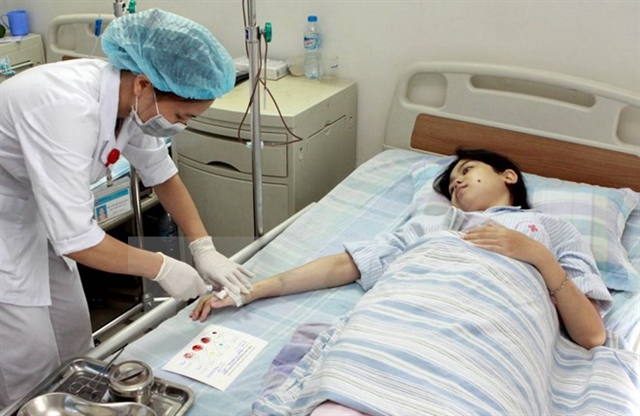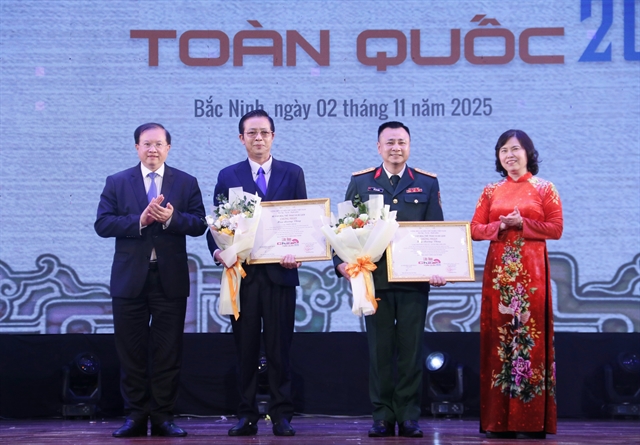 Society
Society

Over the past three years, N T H, a 38-year-old patents from Mekong Delta of An Giang, regularly visits the National Institute of Hematology and Blood Transfusion for chronic myeloid leukemia treatment.

|
| A patient receives treatment a hospital in Hà Nội. VNA/VNS Dương Ngọc |
HCM CITY — Over the past three years, N T H, a 38-year-old woman from the Mekong Delta province of An Giang, has visited the National Institute of Hematology and Blood Transfusion for chronic myeloid leukaemia treatment.
H must take four tablets of Glivec a day, a drug which are used by patients suffering from cancer, including chronic myelogenous leukaemia (CML) and gastro-intestinal stromal tumours. On average, she receives 120 tablets for free every month.
However, during a recent re-examination, she was informed the financial aid would cease and she was only given 48 pills for the month.
H was worried she would have to stop using the medicine as she couldn't afford to continue treatment.
V Đ, a resident from HCM City, faced a similar problem.
“I stopped using the medicine over the past two days. But then I decided to spend VNĐ3 million (US$130) to buy some because I’m not sure what would happen if it is halted,” Đ told Tuổi trẻ (Youth) newspaper.
With a market price of VNĐ120,000 ($5.2) per tablet, a patient has to pay VNĐ480,000 ($20.8) for a four-tablet dose .
The medicine cost is a significant burden for a poor family like Đ's.
According to Phù Chí Dũng, director of HCM City Hospital of Haematology and Blood Transfussion, Glivec had been distributed to patients suffering from chronic myelogenous leukemia through two programmes sponsored by Norvartis Pharma Service – AG Company (Switzerland) since January 2015.
Patients that haven't paid insurance fees for more than 36 consecutive months were given free Glivec medicine by Novartis under the Glivec International Patient Assistance Programme.
For those who have paid insurance for more than 36 consecutive months, the health insurance fund will pay for 40 per cent of their treatment, with the rest sponsored by Novartis.
However, the two programmes ended on December 31.
Due to a lack of medicine to replace Glivec to treat patients suffering from CML, the hospital would base prescriptions on each patient's condition, Dũng said.
The hospital had submitted a report to the city’s Department of Health and the Ministry of Health regarding the situation, he said.
Diệp Bảo Tuấn, deputy director of HCM City Oncology Hospital, said the hospital was treating 200 patients using Glivec and it brought positive results.
“The medicine is very expensive. Each patient would have to pay about VNĐ500 million ($21,600) a year without insurance and financial aid,” he said.
“Patients have had to use their money to purchase the medicine to continue treatment after Novartis stopped financial aid on December 31.”
In response to an inquiry about whether there would be complications from temporarily stopping taking this medicine, Bạch Quốc Khánh, Director of the National Institute of Hematology and Blood Transfusion, said that if a person stopped taking the medicine for one month, there would be no complications, but the disease would resume if they stopped using it for six months.
Similar situation had occurred in 2018, affecting more than 2,000 patients.
The shortage of Glivec and Tasigna for cancer treatment has been blamed on cumbersome procedures. Novartis was reported to have faced difficulties in applying for permission to import medicines due to new and complex procedures.
To settle the problem, the Government has agreed to apply old procedures to import medicines.
Statistics from Việt Nam Social Security (VSS) showed about 3,000 Vietnamese patients were using Glivec or Tasigna, another anti-cancer drug.
The VSS has to spend VNĐ225-413 million per patient per year and nearly 1,500 patients receive the medicine free of charge. — VNS




